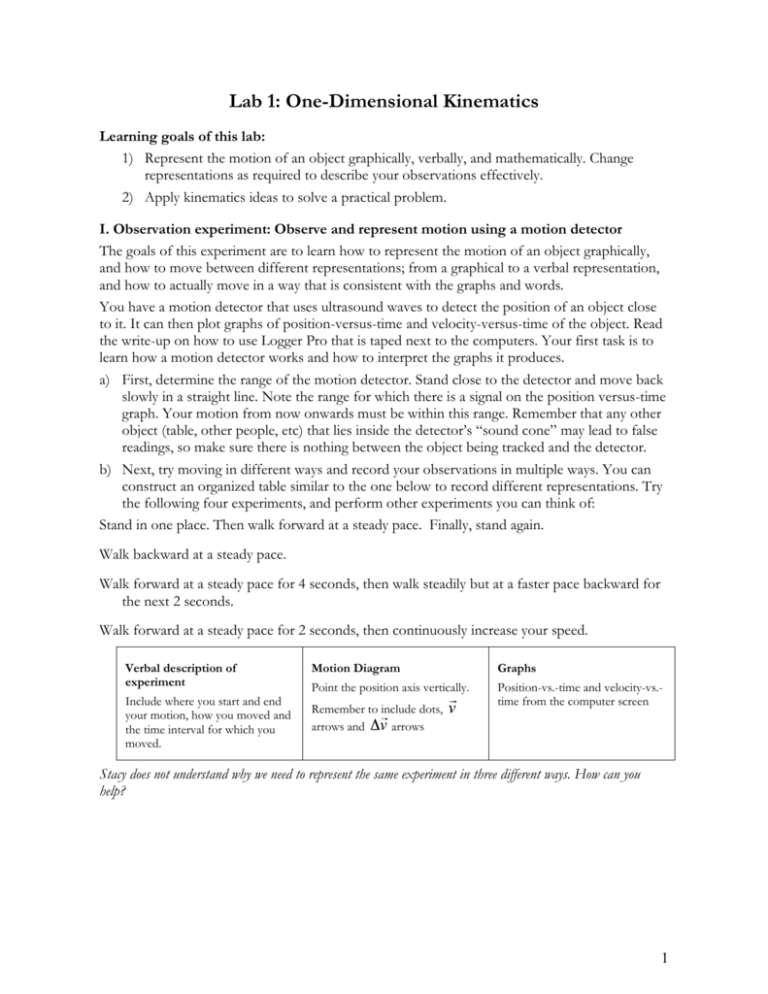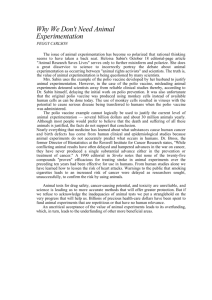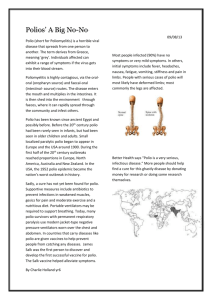Lab 1: One-Dimensional Kinematics
advertisement

Lab 1: One-Dimensional Kinematics Learning goals of this lab: 1) Represent the motion of an object graphically, verbally, and mathematically. Change representations as required to describe your observations effectively. 2) Apply kinematics ideas to solve a practical problem. I. Observation experiment: Observe and represent motion using a motion detector The goals of this experiment are to learn how to represent the motion of an object graphically, and how to move between different representations; from a graphical to a verbal representation, and how to actually move in a way that is consistent with the graphs and words. You have a motion detector that uses ultrasound waves to detect the position of an object close to it. It can then plot graphs of position-versus-time and velocity-versus-time of the object. Read the write-up on how to use Logger Pro that is taped next to the computers. Your first task is to learn how a motion detector works and how to interpret the graphs it produces. a) First, determine the range of the motion detector. Stand close to the detector and move back slowly in a straight line. Note the range for which there is a signal on the position versus-time graph. Your motion from now onwards must be within this range. Remember that any other object (table, other people, etc) that lies inside the detector’s “sound cone” may lead to false readings, so make sure there is nothing between the object being tracked and the detector. b) Next, try moving in different ways and record your observations in multiple ways. You can construct an organized table similar to the one below to record different representations. Try the following four experiments, and perform other experiments you can think of: Stand in one place. Then walk forward at a steady pace. Finally, stand again. Walk backward at a steady pace. Walk forward at a steady pace for 4 seconds, then walk steadily but at a faster pace backward for the next 2 seconds. Walk forward at a steady pace for 2 seconds, then continuously increase your speed. Verbal description of experiment Include where you start and end your motion, how you moved and the time interval for which you moved. Motion Diagram Graphs Point the position axis vertically. Position-vs.-time and velocity-vs.time from the computer screen Remember to include dots, arrows and arrows Stacy does not understand why we need to represent the same experiment in three different ways. How can you help? 1 II. Testing experiment: Do you understand graphs? Your next task is to move in such a way that the graphs produced by your motion match those in the files. Read the instructions about which files to open, and how to match graphs. Then write the following: a) Draw the graph you are supposed to match. b) Before you proceed to perform the experiment, you need to decide how you will move. Predict, based on your observations from above and your knowledge of kinematics, how you should move to produce graphs that match those that are on the screen. c) After you are sure how you want to move, invite your instructor to watch you and then perform the experiment. d) If the graph produced by your motion did not match the provided graphs, discuss possible reasons. e) Where in the graph is the position of the object represented? Where is the time represented? f) What is the independent variable? How do you know? g) How do several motions that are represented by x(t) lines with various slopes differ from each other? What information can we obtain from the slope of x(t) graph? h) Use the motion detector to find whether a medicine ball and a basketball fall with constant acceleration. If they do, record the value of their accelerations. 2 III. Application experiments: Where do the cars meet? Here you will perform two experiments; the goals of them are i) to apply kinematics equations to describe real-life phenomena and ii) to differentiate between assumptions that one makes when applying mathematical equations to a real situation and experimental uncertainties that one cannot avoid using particular equipment. Self-assessment - to help you improve your experimental abilities, reasoning abilities and communication abilities we provide you with self-assessment rubrics. You received the rubrics at the first lab meeting. Familiarize yourself with the ones mentioned below; we will use the rest as needed. Use them to guide you through the design and completion of your lab report. D4, D8, G1, G2, G4 Experiment In this experiment you will determine the type of motion of two toy cars and then figure out the point where the two cars meet if they start their motion at given locations and move toward each other. Available equipment: Two battery-operated cars, meter stick, stopwatch, sugar packets. Part I First, experiment individually with the two cars to determine how each of them moves (constant speed, changing speed at a constant rate, etc.) and describe each car’s motion quantitatively, that is, with an equation of the type x(t)=... You can use the methods you learned in the first lab to record positions of the cars every second. Use the following steps: a) Draw a clearly labeled sketch of your experimental set-up. b) Perform the experiment. Record the data in appropriate formats such as a motion diagram, a table, and a graph. c) List the sources of experimental uncertainty. Write down the absolute value for each uncertainty. Write the relative uncertainties (you can make a table). Compare them to determine if you can use the weakest link rule (see the “guide”). d) List steps you could take to minimize the uncertainties. e) Describe in words the motion of each car and how you arrived at this conclusion. f) Describe the position of each car as a function of time x(t) = … Part II Calculate where the cars will meet if they start 2.0 m apart at the same time. To do this, follow the steps below. a) Use the x(t) functions describing the motion of the two cars to find out where they would meet. b) When you make the calculation, think of the assumptions that you are using. One of them is that the cars move at constant speed right from the start of the measurement. Will this assumption affect the meeting location? If yes, then how? c) What are other assumptions? Think of the floor. d) How can you explain to Stacy the differences between the calculated value and the outcome of the experiment? (Hint: think of experimental uncertainties and your assumptions). e) Construct a poster of your experiment and do a 2-3 minute group presentation of your experiment. Poster must include: title, hypothesis, diagram of experimental set up, graph of data and conclusion: scientific explanation for the results. 3 f) Extension: You have noticed that the buggies travel at a constant rate. What will happen if one of the vehicles accelerated? How does the shape of the lines of the graph change? How the prediction can be made? How can be done experimental? g) Today you have just conducted an observation experiment and an application experiment. How are they different? IV. Why did we do this lab? a) Give real-life examples of instances when people need to collect and analyze quantitative data (numbers with units) to describe and understand events. b) Explain how your understanding of representations of motion is different now compared to before the lab. 4 V. Homework: please complete the homework before coming to lab 3. This homework will prepare you for the third lab where you will have to design and conduct a testing experiment. Read the following passage focusing your attention on the scientific procedures and scientific abilities illustrated in it. Think about what types of experiments (observation, testing or application) are described. Identify the hypothesis, predictions, outcomes of experiments and assumptions that appear in the passage. The standard explanation of how humans originally acquired AIDS is that HIV (human immunodeficiency virus) originally was transmitted to humans from monkeys or apes carrying SIV, simian immunodeficiency virus. How could the transmission have occurred? Several similar hypotheses involve an African hunter coming in contact with monkey blood. For example this could have occurred when a hunter butchering a monkey, got some of its blood in a cut, or when a human ate undercooked monkey meat, or when a monkey bit a human. Depending on one's assessment of the genetic diversity of HIV over time, this transmission might have occurred only a few decades ago or, alternatively, hundreds or thousands of years ago. If the latter is correct then AIDS could have been restricted to remote African villages until recent decades when trade and international travel led to the current pandemic. There are however other alternative explanations for the spread of AIDS. One of them is that AIDS arose from contaminated polio vaccines used in Africa from 1957-59. Why is this a plausible explanation? Polio vaccines are cultured on apes’ kidneys, so contamination of a batch of vaccine by an SIV is a possibility. There is a precedent: in the 1950s and early 1960s millions of doses of polio vaccine were contaminated by another simian virus, SV-40. The vaccine alleged to be the origin of AIDS was given to hundreds of thousands of people in central and west Africa from 1957-1959. These locations later had some of the world's highest levels of HIV infection. The timing is also right, since the earliest known cases of AIDS date from the 1960s; the earliest HIV-positive blood sample was collected in Kinshasa in 1959. At the time, there was no way of testing for the presence of SIVs, which were only discovered in the 1980s. Another factor adds plausibility to the theory: the vaccine was given to many infants less than a month old, in an extra high dose. Since the immune systems of infants are not fully developed, this is an excellent way to help a virus jump the species barrier. Some scientists argue that the above explanation is not necessarily correct but that it is worth taking seriously. There are a number of ways to test it. One is to analyze stocks of polio vaccine; if the explanation is correct, then it is probable that some of the vaccines will carry SIV. Another is to scrutinize records of early polio vaccination campaigns in Africa. If it is true that the immunodeficiency virus passed to humans by way of those vaccines, the areas where the campaigns took place would be the same as those where the initial sprouts of the disease occurred and where the larger number of cases occurred during the early stages of the pandemic. Another is to analyze blood samples in Africa from the 1950s and earlier (pre polio vaccination): if the immunodeficiency virus was transmitted via the polio vaccine, HIV should not be found. Adapted from “Political refutation of a scientific theory: the case of polio vaccines and the origin of AIDS”. Brian Martin, published in Health Care Analysis, Vol. 6, 1998, pp. 175-179. Now reread the passage and answer the following questions. 1) What are the different hypotheses of how AIDS was transmitted from apes to human that appear in the above excerpt? 2) List the experiments proposed in the passage. 3) What type of experiments (observation, testing or application) are they? How do you know? 4) What does the explanation of the transmission via polio vaccination predict for the outcomes of each of those experiments? 5) For each experiment, write an outcome that would disprove the hypothesis of AIDS passing from monkeys to humans through polio vaccines. 6) What outcomes of the experiments would fail to disprove the hypothesis of AIDS passing from monkeys to humans through polio vaccines? Explain. 7) What outcomes would prove the hypothesis? 8) For what reasons do scientists need to conduct testing experiments? 5






